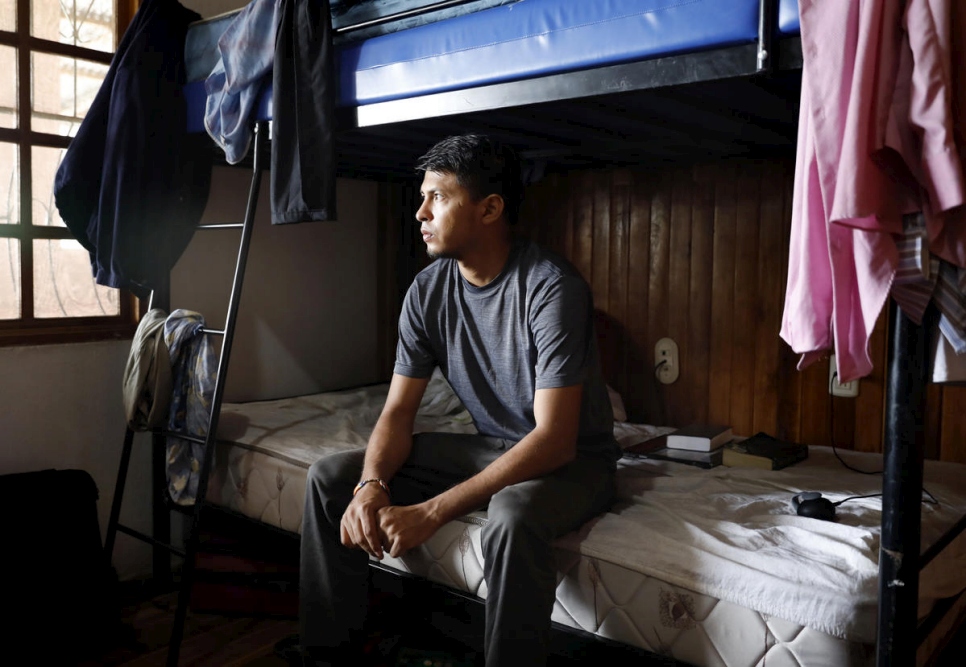Nicaraguan students forced to flee find safety, solidarity in Costa Rica
Students led anti-government protests and many have sought security abroad since a bloody crackdown began nearly two years ago.

Arturo, 27, fled from Nicaragua to Costa Rica, where he is living in a temporary shelter. © UNHCR/Daniel Dreifuss
Engineering major Arturo* was in his fifth and final year of college when anti-government protests broke out in his native Nicaragua in early 2018.
University students played a major role in the demonstrations, and Arturo, a bright and articulate 27-year-old, soon gained visibility in the student movement. But that visibility put him in danger.
In October 2018, he was standing outside the Managua workshop where he worked to help pay for his studies when suddenly, several men, their faces covered, jumped out of nearby cars. After a dramatic chase, he was beaten, handcuffed, and taken to jail. The beatings continued but thanks to a security camera video of his capture, he was released after 18 days.
Soon after he was freed, Arturo slipped over the border to Costa Rica, joining tens of thousands of others who have fled Nicaragua since the anti-government demonstrations erupted in April 2018.
Ensuing clashes in the Central American nation have since killed more than 300 people according to a tally by the Inter-American Commission on Human Rights. More than 2,000 have been injured, and an unknown number detained.

Nicaraguan refugee yearns for diploma 'lost' to political tumult (Jenny Barchfield and Diana Diaz, producers / Gabriel Serra and Fernando Fonseca, cameraperson / Arturo Almenar, editor)
Nearly two years later, Nicaraguans continue to flee – an average of 4,000 seek safety abroad every month. Most go to Costa Rica where more than two thirds of the 103,600 Nicaraguans who have fled their country have applied for asylum. Thousands more are in other countries.
And while Costa Rica has maintained an open-door policy toward those fleeing persecution, the influx of Nicaraguans has strained the small Central American nation’s asylum system.
To handle the growing number of asylum claims, Costa Rican authorities, with support from UNHCR, the UN Refugee Agency, have worked to streamline the refugee recognition process by using broad profiles of those who are known to be persecuted in Nicaragua.
These include as students – like Arturo – journalists and farm workers who have been targeted for protesting plans to build an interoceanic canal across their lands. This has meant quicker processing of asylum claims and a higher rate of recognition for Nicaraguans.
“My dream is to be an engineer.”
For Edwin*, a 30-year-old graphic design student from Managua who also fled after participating in the protests, being recognized as a refugee in Costa Rica would change everything.
“I wish I had it already!” he said, adding that his interview with local refugee authorities is set for May. “It will mean getting a work permit and even something simple like being able to sign up for an internet plan so that I can communicate with my family.”
He is also hoping to access Costa Rica’s health care system, which recently announced it would incorporate 6,000 refugees and asylum seekers to the social security system. “I have problems with my kidneys and the medicine here is very expensive,” said Edwin.
Edwin has not given up on finishing his studies – if he can ever get his transcripts from Nicaragua. But for now he is dedicated to something that the urban student never through he would do: raise pigs.
Living in a rural area in the north of the Costa Rica, he has had to learn to care for the hogs, many of them expectant sows, held in pens. “I’ve brought 22 little pigs into this world,” he said. “I still can’t believe I’m doing this.”
Arturo, the engineering student, has also been unable to request his academic transcripts to be able to enroll in a university in Costa Rica. But he has not wavered in his determination to complete his studies.
“My dream is to be an engineer,” he said.
* Names changed to protect identities.
